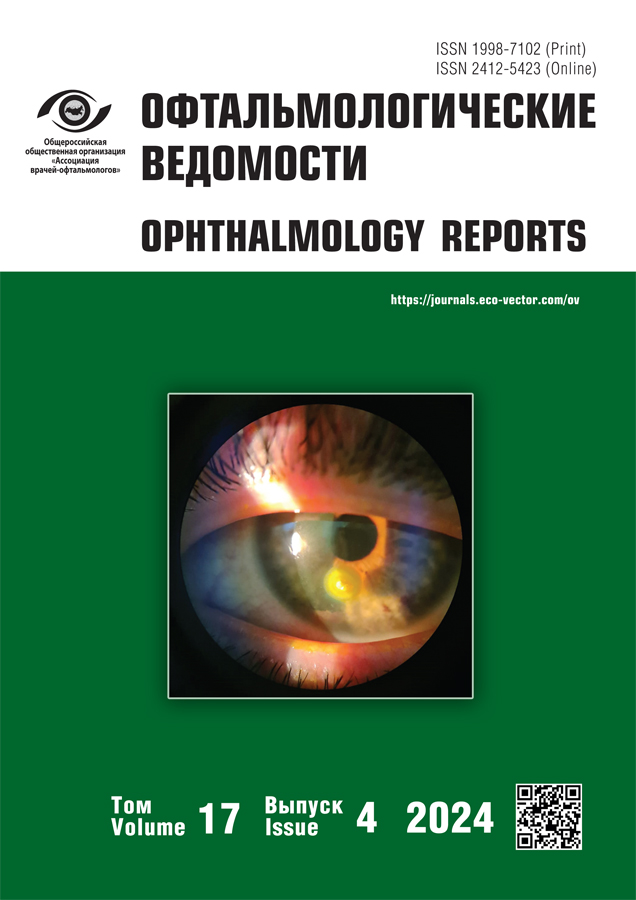Method of intraocular lens fixation in patients with compensated glaucoma and cataract complicated by zonular weakness
- Authors: Ivachev E.A.1,2, Kochergin S.A.3, Ivacheva O.T.2
-
Affiliations:
- Clinical Hospital Railways-Medicine
- Penza State University
- Russian Medical Academy of Continuous Professional Education
- Issue: Vol 17, No 4 (2024)
- Pages: 37-44
- Section: Original study articles
- URL: https://journal-vniispk.ru/ov/article/view/280528
- DOI: https://doi.org/10.17816/OV633975
- ID: 280528
Cite item
Abstract
BACKGROUND: The combination of cataract and glaucoma occurs in 14.6–76% of cases, and zonular weakness — in 34%. By suturing the lens in the posterior chamber, ophthalmic surgeons create a more physiological position for it.
AIM: The aim of this study is to evaluate the clinical efficacy of intraocular lens fixation in patients with compensated glaucoma and cataract complicated by zonular weakness.
MATERIALS AND METHODS: 49 patients with compensated glaucoma and cataract complicated by zonular weakness were operated. Uncorrected visual acuity — 0.19, best corrected visual acuity — 0.25, tonometric intraocular pressure — 18.9 mm Hg. Operation technique: a corneal tunnel is formed at 9 o’clock, 4 iris-retractors are inserted through paracenteses at 2, 5, 8, 11 hours and fixed at the edge of the capsulorhexis. After lens extraction, 2 iris-retractors (at 5, 11 hours) are removed . The lens is implanted into the anterior chamber. Haptic elements are tucked under the iris in the projection of 5 and 11 hours, the optical part is transferred to the posterior chamber. The support elements are sutured with interrupted sutures to the iris, then 2 iris-retractors are removed (at 2 and 8 hours), the capsular bag is removed using tweezers, and the paracenteses and the tunnel are hydrated.
RESULTS: On the first day, the best corrected visual acuity was 0.34, by the 5th day, it increased to 0.49 ± 0.08, by the 14th day — 0.52. As the glaucoma process progressed during 2 years after surgery, best corrected visual acuity decreased to 0.47, intraocular pressure was 18.4 mm Hg.
CONCLUSIONS: An original and easy to perform suture fixation of the lens to the iris is proposed, which allows to reduce the risk of lens decentration and tilt, as well as that of vitreous herniation.
Full Text
##article.viewOnOriginalSite##About the authors
Evgenii A. Ivachev
Clinical Hospital Railways-Medicine; Penza State University
Author for correspondence.
Email: eivachov1@yandex.ru
ORCID iD: 0000-0001-5662-4195
SPIN-code: 7766-1251
MD, Cand. Sci. (Medicine)
Russian Federation, Penza; PenzaSergei A. Kochergin
Russian Medical Academy of Continuous Professional Education
Email: prokochergin@rambler.ru
ORCID iD: 0000-0002-8913-822X
MD, Dr. Sci. (Medicine)
Russian Federation, MoscowOlga T. Ivacheva
Penza State University
Email: leila250788@gmail.com
ORCID iD: 0000-0001-9180-1273
MD
Russian Federation, PenzaReferences
- Malyugin BE, Panteleev EN, Khapaeva LL, Savenkov SG. Mixed ciliary-capsular fixation of a three-piece IOL during phacoemulsification in patients with the lenticular ligamentous-capsular system’s failure. Fyodorov Journal of Ophthalmic Surgery. 2023;(1):6–17. EDN: FIPSHI doi: 10.25276/0235-4160-2023-1-6-17
- Sazhin TG, Sokolova MO. Sclerocorneal fixation of posterior chamber intraocular lenses in complicated cases of cataract surgery using polytetrafluoroethylene suture. Fyodorov Journal of Ophthalmic Surgery. 2024;142(1):13–20. EDN: AJXKXG doi: 10.25276/0235-4160-2024-1-13-20
- Ioshin IE, Tolchinskaya AI. Surgical treatment of patients with bilateral cataracts. Fyodorov Journal of Ophthalmic Surgery. 2013;(2):10–15. EDN: RAQGAF
- Pashtaev NP, Kulikov IV. Subluxated cataract surgery. Practical Medicine. 2017;2(9):155–157. EDN: ZNLTVF
- Desai MA, Lee RK. The medical and surgical management of pseudoexfoliation glaucoma. Int Ophthalmol Clin. 2008;48(4):95–113. doi: 10.1097/IIO.0b013e318187e902
- Ling JD, Bell NP. Role of cataract surgery in the management of glaucoma. Int Ophthalmol Clin. 2018;58(3):87–100 doi: 10.1097/IIO.0000000000000234
- Kozhukhov AA, Kapranov DO, Ovechkin IG, Ovechkin NI. Development and evaluation of clinical efficacy of intraocular lens fixation after cataract phacoemulsification, complicated by capsular lenticular disruption. Ophthalmology in Russia. 2018;15(2):124–131. EDN: XRVFBJ doi: 10.18008/1816-5095-2018-2-124-131
- Tulina VM, Abramova IA, Grigoriev IA, Kamilov AKh. A foldable intraocular lens implantation into the ciliary body sulcus with scleral suturing in patients with inadequate capsular support. Ophthalmology Reports. 2014;7(2):30–35 EDN: SOAPAR
- Shah R, Weikert M, Grannis C, et al. Long-term outcomes of iris-sutured posterior chamber intraocular lenses in children. Am J Ophthalmol. 2016;161:44–49. doi: 10.1016/j.ajo.2015.09.025
- Patent RU No. 2681108C1/ 04.03.2019. Bogomolov AV. Method of suturing an intraocular lens to the iris. Available at: https://yandex.ru/patents/doc/RU2681108C1_20190304
- Patent RU No. 2681108C1/ 14.02.2023. Timofeev VL, Nikulin ME, Shilovskikh AO. Method for fixing an intraocular lens to the iris. Available at: https://yandex.ru/patents/doc/RU2789976C1_20230214
- Ivanov DI, Bardasov DB. Technology of phacoemulsification in extensive zonular defects of zinn ligament fibers. Kazan Medical Journal. 2013;94(4):580–585. (In Russ.) EDN: QZIOPL
- Zhaboiedov DG. Suture fixation of the SL-907 Centrix DZ IOL to the iris with capsular support failure. Ecological Problems of Experimental and Clinical Medicine. 2014;(3):210–215. (In Russ.)
- Parker DS, Price FW. Suture fixation of a posterior chamber intraocular lens in anticoagulated patients. J Cataract Refract Surg. 2003;29(5):949–954. doi: 10.1016/s0886-3350(02)01810-2
- Mura JJ, Pavlin CJ, Condon GP. Ultrasound biomicroscopic analysis of iris-sutured foldable posterior chamber intraocular lenses. Am J Ophthalmol. 2010;149(2):245–252. doi: 10.1016/j.ajo.2009.08.022
Supplementary files













